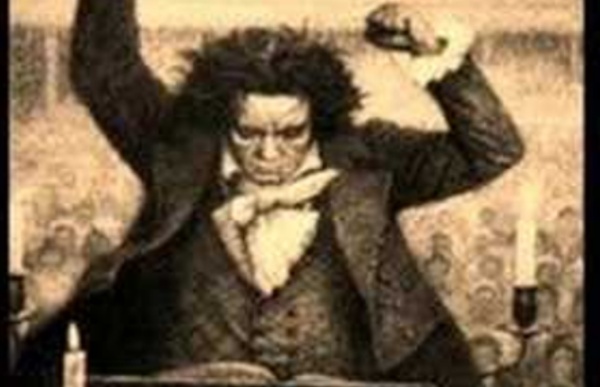



http://www.youtube.com/watch?v=_4IRMYuE1hI
The Young Person's Guide to the Orchestra The Young Person's Guide to the Orchestra , Op. 34, is a musical composition by Benjamin Britten in 1946 with a subtitle " Variations and Fugue on a Theme of Purcell ". It was originally commissioned for an educational documentary film called The Instruments of the Orchestra, directed by Muir Mathieson and featuring the London Symphony Orchestra conducted by Malcolm Sargent . The work is one of the best-known pieces by the composer, and is one of the three popularly used scores in children's music education , together with Saint-Saëns ' The Carnival of the Animals and Prokofiev 's Peter and the Wolf .
Frédéric Chopin Photograph of Chopin by Bisson, c. 1849 Frédéric François Chopin (/ˈʃoʊpæn/; French pronunciation: [fʁe.de.ʁik ʃɔ.pɛ̃]; 22 February or 1 March 1810 – 17 October 1849), born Fryderyk Franciszek Chopin,[n 1] was a Romantic-era Polish composer. A child prodigy, Chopin was born in what was then the Duchy of Warsaw. He grew up in Warsaw, which after 1815 became part of Congress Poland, and there completed his musical education and composed many of his works before leaving Poland, aged 20, less than a month before the outbreak of the November 1830 Uprising. Piano Concerto No. 2 (Rachmaninoff) The Piano Concerto No. 2 in C minor, Op. 18, is a concerto for piano and orchestra composed by Sergei Rachmaninoff between the autumn of 1900 and April 1901.[1] The second and third movements were first performed with the composer as soloist on 2 December 1900.[2] The complete work was premiered, again with the composer as soloist, on 9 November 1901,[2] with his cousin Alexander Siloti conducting. This piece is one of Rachmaninoff's most enduringly popular pieces,[3] and established his fame as a concerto composer.[4] Rachmaninoff in the early 1900s Main theme first played by the two violin sections, viola section and first clarinet The agitated and unstable development borrows motives from both themes changing keys very often and giving the melody to different instruments while a new musical idea is slowly formed.
Ludwig van Beethoven Ludwig van Beethoven ( i/ˈlʊdvɪɡ væn ˈbeɪ.toʊvən/; German: [ˈluːtvɪç fan ˈbeːt.hoːfən] ( Born in Bonn, then the capital of the Electorate of Cologne and part of the Holy Roman Empire, Beethoven displayed his musical talents at an early age and was taught by his father Johann van Beethoven and Christian Gottlob Neefe. During his first 22 years in Bonn, Beethoven intended to study with Wolfgang Amadeus Mozart and befriended Joseph Haydn. Beethoven moved to Vienna in 1792 and began studying with Haydn, quickly gaining a reputation as a virtuoso pianist. He lived in Vienna until his death.
Nikolai Rimsky-Korsakov Portrait of Nikolai Rimsky-Korsakov in 1898 by Valentin Serov (detail) Rimsky-Korsakov believed, as did fellow composer Mily Balakirev and critic Vladimir Stasov, in developing a nationalistic style of classical music. This style employed Russian folk song and lore along with exotic harmonic, melodic and rhythmic elements in a practice known as musical orientalism, and eschewed traditional Western compositional methods. Franz Schubert 1875 oil painting by Wilhelm August Rieder, after his own 1825 watercolor portrait Franz Peter Schubert (German pronunciation: [ˈfʁant͡s ˈʃuːbɐt]; 31 January 1797 – 19 November 1828) was an Austrian composer. In a short lifespan of less than 32 years, Schubert was a prolific composer, writing some 600 Lieder, ten complete or nearly complete symphonies, liturgical music, operas, incidental music and a large body of chamber and solo piano music. Appreciation of his music while he was alive was limited to a relatively small circle of admirers in Vienna, but interest in his work increased significantly in the decades immediately after his death.
Sergei Prokofiev Sergei Prokofiev in New York, 1918 Biography[edit] Early childhood and first compositions[edit] Sergei Rachmaninoff Sergei Rachmaninoff Sergei Vasilievich Rachmaninoff (Russian: Серге́й Васи́льевич Рахма́нинов;[1] Russian pronunciation: [sʲɪrˈɡʲej rɐxˈmanʲɪnəf]; 1 April [O.S. 20 March] 1873 – 28 March 1943)[2] was a Russian composer, pianist, and conductor.[3] Rachmaninoff is widely considered one of the finest pianists of his day and, as a composer, one of the last great representatives of Romanticism in Russian classical music.[4] Early influences of Tchaikovsky, Rimsky-Korsakov, and other Russian composers gave way to a personal style notable for its song-like melodicism, expressiveness and his use of rich orchestral colors.[5] The piano is featured prominently in Rachmaninoff's compositional output, and through his own skills as a performer he explored the expressive possibilities of the instrument.